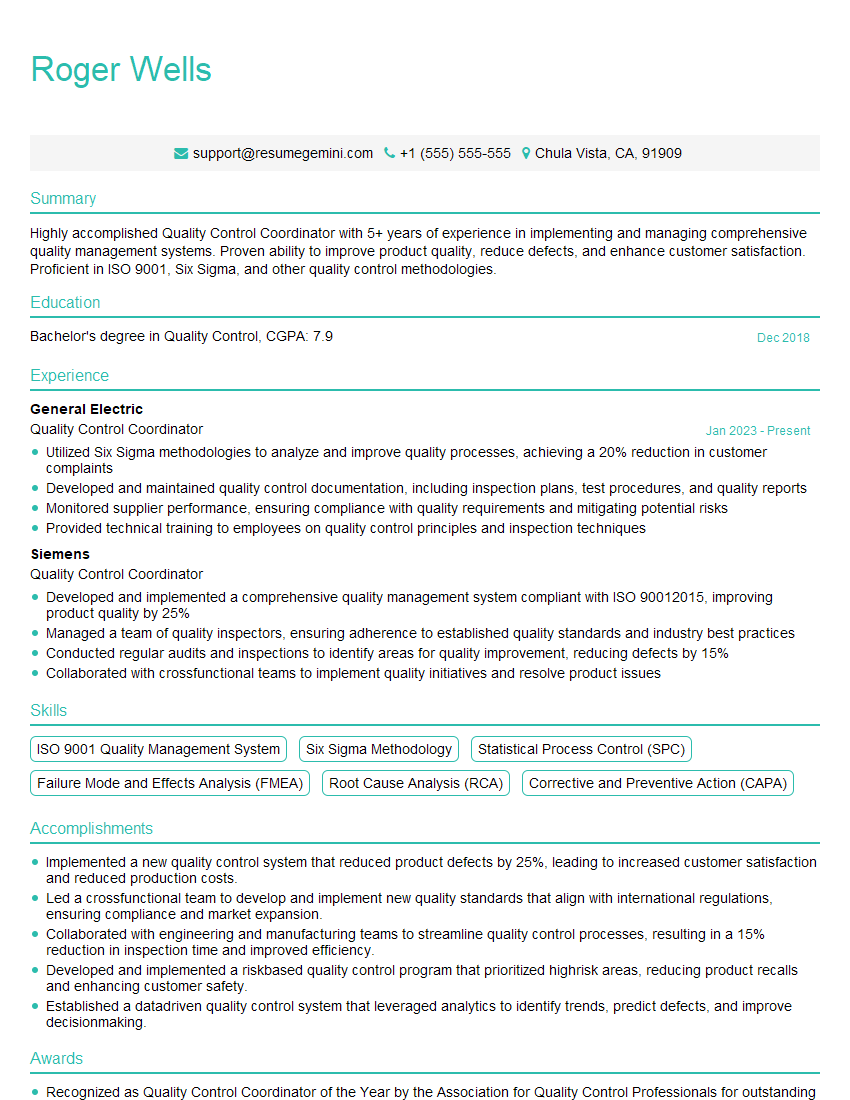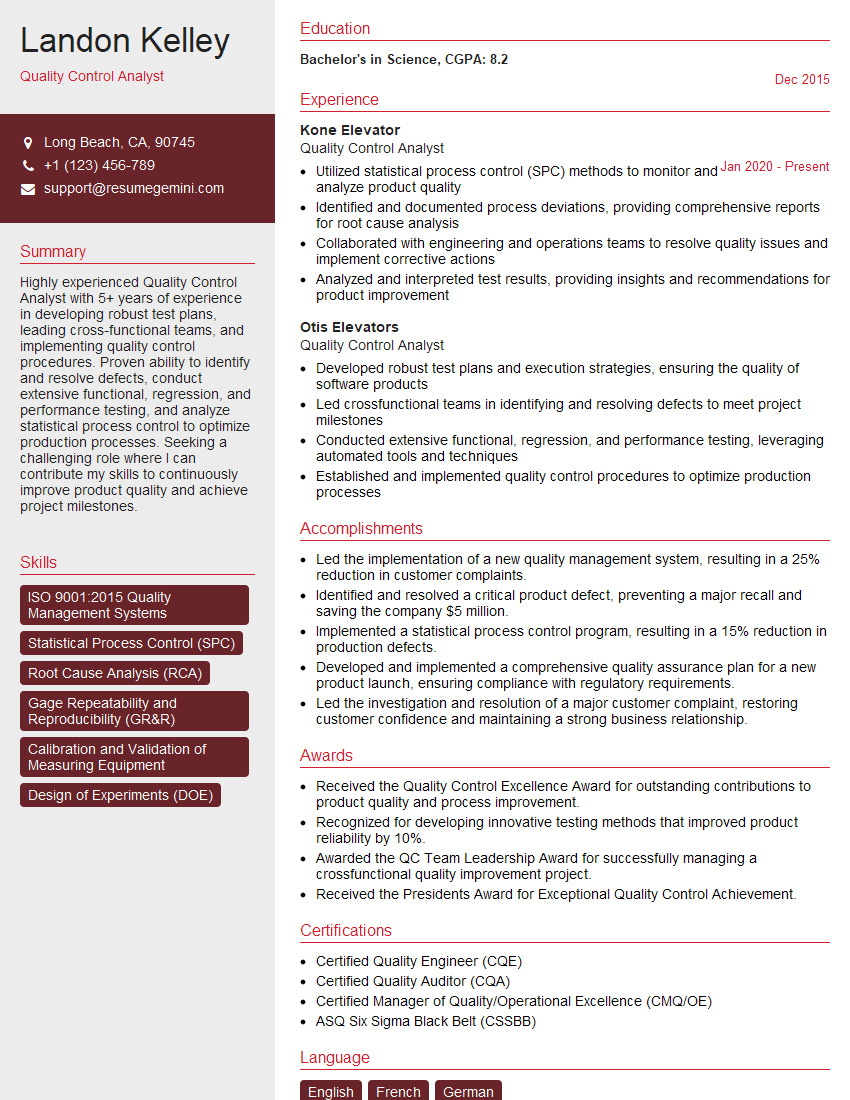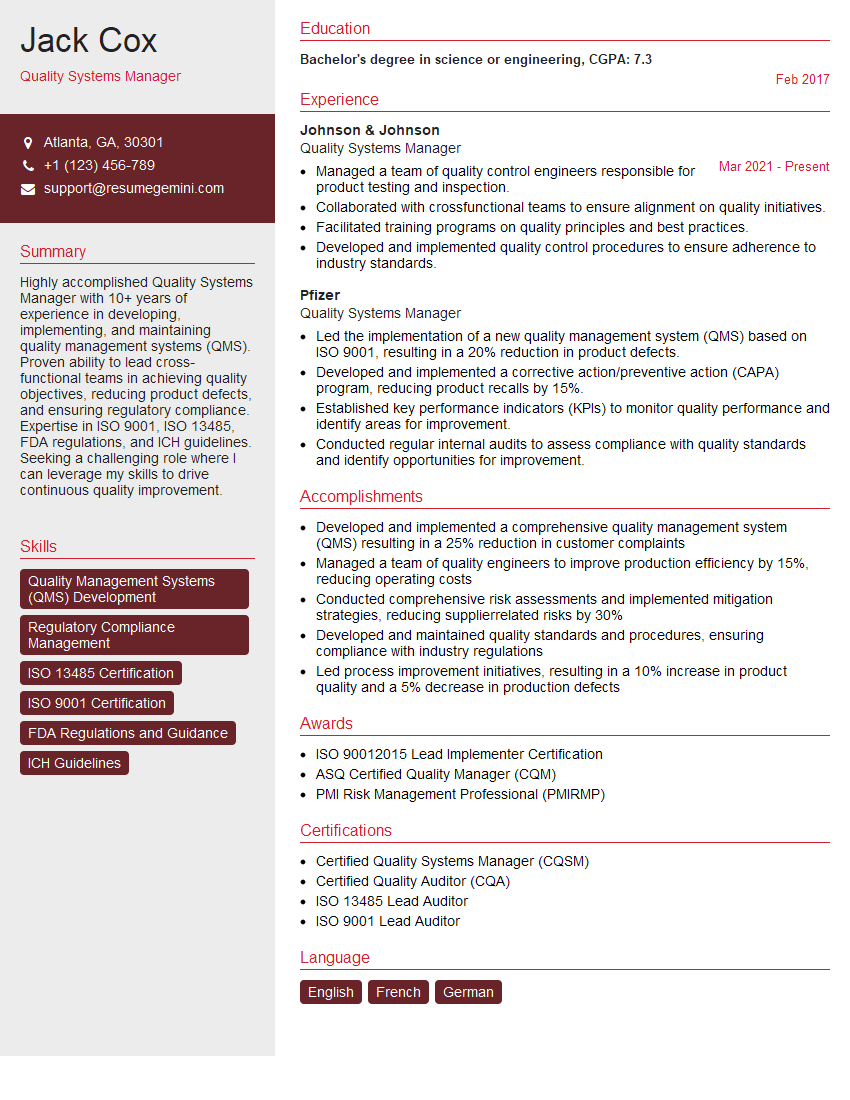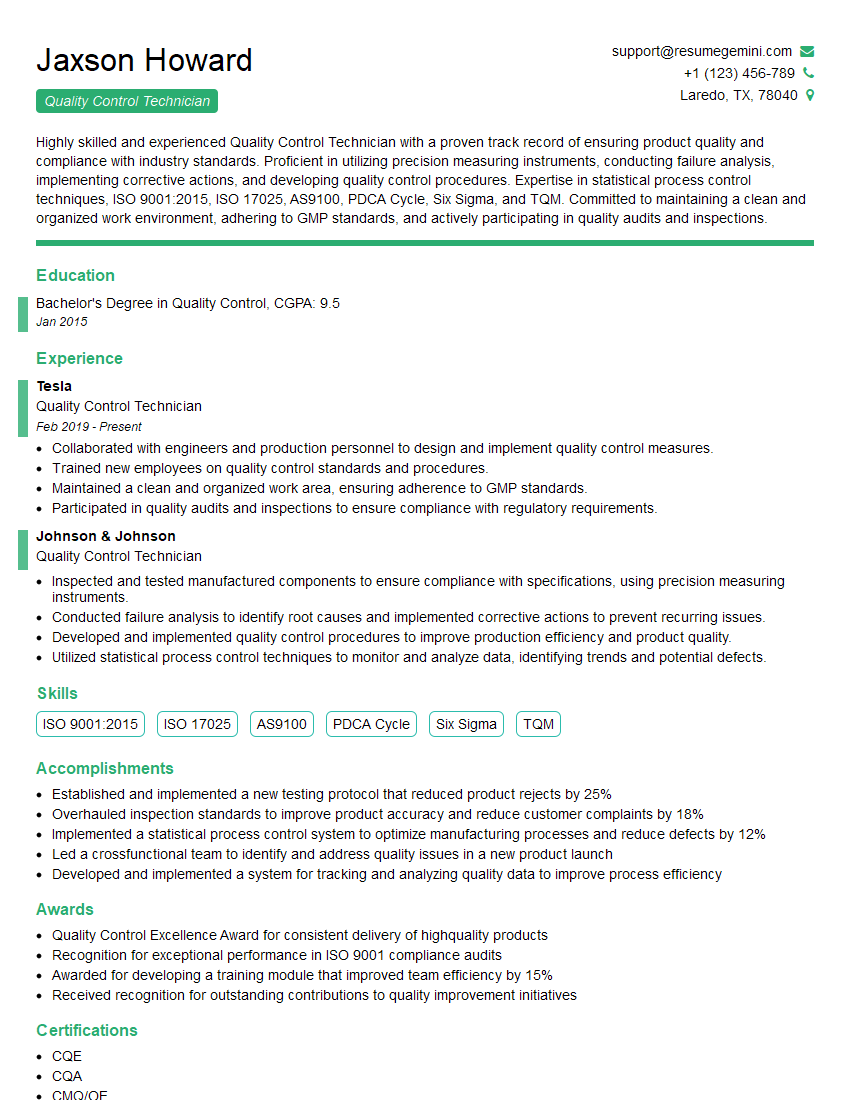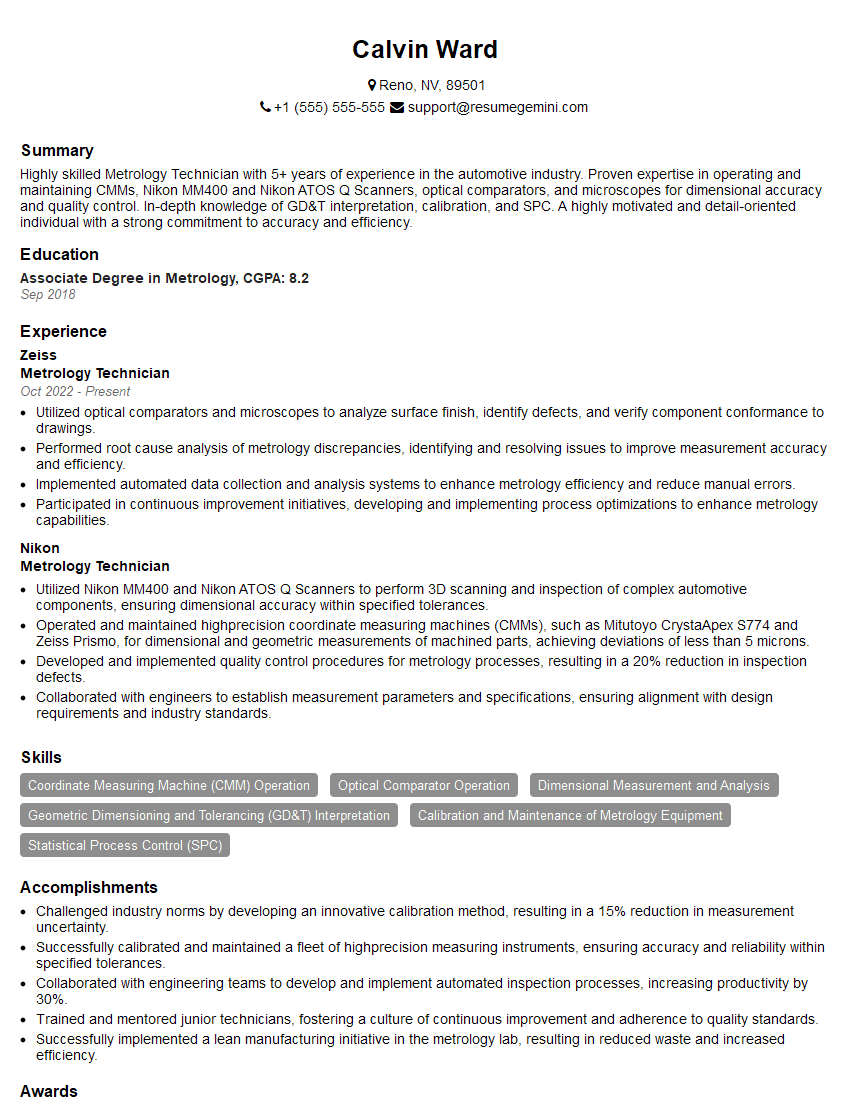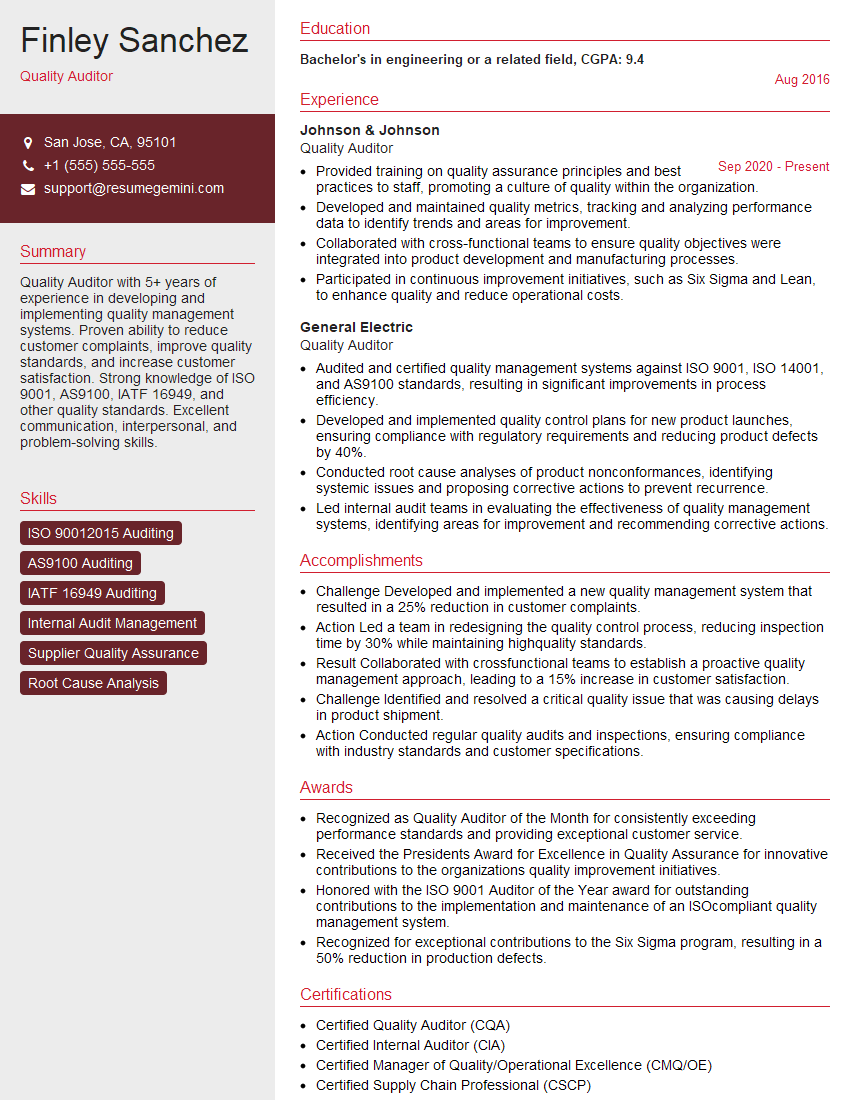Interviews are opportunities to demonstrate your expertise, and this guide is here to help you shine. Explore the essential Manufacturing Quality Control interview questions that employers frequently ask, paired with strategies for crafting responses that set you apart from the competition.
Questions Asked in Manufacturing Quality Control Interview
Q 1. Explain the different types of quality control charts.
Quality control charts are visual tools used to monitor process performance and identify potential issues. They plot data points over time, allowing for easy detection of trends, shifts, or unusual variations. Different chart types are chosen based on the type of data being monitored.
- Control Charts for Variables: These charts track continuous data, like dimensions or weights.
- X-bar and R chart: Monitors the average (X-bar) and range (R) of subgroups of data. This is excellent for detecting shifts in the process average or increased variability.
- X-bar and s chart: Similar to X-bar and R, but uses the standard deviation (s) instead of the range. It’s preferred for larger subgroups.
- Control Charts for Attributes: These charts track discrete data, like the number of defects or non-conforming units.
- p-chart: Tracks the proportion of non-conforming units in a sample.
- np-chart: Tracks the number of non-conforming units in a sample.
- c-chart: Tracks the number of defects per unit.
- u-chart: Tracks the number of defects per unit of measurement (e.g., defects per square meter).
For example, in a manufacturing plant producing bolts, we might use an X-bar and R chart to monitor the bolt diameter. If the data points consistently fall outside the control limits, it indicates a problem requiring investigation. Conversely, a p-chart could track the percentage of defective bolts in each batch.
Q 2. Describe your experience with Statistical Process Control (SPC).
My experience with Statistical Process Control (SPC) spans over ten years, encompassing various manufacturing environments. I’ve successfully implemented and managed SPC programs using Minitab and JMP statistical software. I’ve trained operators and engineers in data collection, chart interpretation, and process capability analysis.
In a previous role at a pharmaceutical company, we used SPC to monitor the weight of tablets. By meticulously collecting data and analyzing control charts, we identified a trend of increasing variability in tablet weight, ultimately traced to a worn-out component in the tablet press. Early detection through SPC prevented a significant batch of non-conforming products from entering the market. I’ve also used SPC to improve process capability indices (Cp and Cpk) significantly, reducing defect rates and increasing customer satisfaction.
Q 3. How do you implement and manage a quality management system (e.g., ISO 9001)?
Implementing and managing a Quality Management System (QMS), such as ISO 9001, involves a structured approach. It begins with defining the scope of the QMS, aligning it with the organization’s goals and objectives. This includes clearly defining what processes will be included in the QMS.
Key steps include:
- Documentation: Creating and maintaining comprehensive documented procedures, work instructions, and forms to ensure consistency and traceability.
- Training: Educating employees on their roles and responsibilities within the QMS, ensuring everyone understands the quality policies and procedures.
- Internal Audits: Conducting regular internal audits to verify the effectiveness of the QMS and identify areas for improvement.
- Management Review: Periodically reviewing the QMS’s performance, identifying and addressing any shortcomings, and setting improvement goals.
- Corrective and Preventive Actions (CAPA): Establishing a robust system for addressing non-conformances and preventing their recurrence.
- Continuous Improvement: Embedding a culture of continuous improvement throughout the organization using methodologies like Kaizen or Lean.
For example, during my time at an automotive parts supplier, I led the implementation of ISO 9001. This involved creating detailed procedures for all manufacturing processes, implementing a robust documentation system, and training all personnel on the new QMS. This resulted in improved product quality, enhanced customer satisfaction, and reduced non-conformances.
Q 4. What are your methods for root cause analysis of manufacturing defects?
Root cause analysis is crucial for preventing recurring defects. I utilize several methods depending on the complexity of the issue. These include:
- 5 Whys: A simple, yet effective technique that involves repeatedly asking ‘Why?’ to uncover the underlying causes of a problem.
- Fishbone Diagram (Ishikawa Diagram): A visual tool that organizes potential causes into categories (e.g., materials, methods, manpower, machinery, environment, measurement). It helps to brainstorm and identify potential causes systematically.
- Fault Tree Analysis (FTA): A top-down, deductive approach that uses Boolean logic to identify the root causes that can lead to a specific undesirable event.
- Pareto Analysis: Focuses on identifying the vital few causes that account for the majority of the problems. This allows us to prioritize our efforts in addressing the most significant issues.
For example, if we find excessive surface scratches on a finished product, we might use the 5 Whys: Why are there scratches? Because the polishing machine is worn. Why is it worn? Because it wasn’t properly maintained. Why wasn’t it maintained? Because the maintenance schedule wasn’t followed. Why wasn’t the schedule followed? Because of inadequate training. This identifies inadequate training as the root cause, allowing us to address the problem effectively.
Q 5. Explain your experience with different inspection methods (visual, dimensional, functional).
My experience encompasses a wide range of inspection methods, each with its strengths and limitations:
- Visual Inspection: This involves using the human eye, often with magnifying glasses or microscopes, to detect surface defects, imperfections, or deviations from specifications. It’s cost-effective for many applications but can be subjective and prone to human error.
- Dimensional Inspection: This uses precision measuring instruments (e.g., calipers, micrometers, coordinate measuring machines) to verify the physical dimensions of a product against the design specifications. It ensures accurate size and tolerances.
- Functional Inspection: This involves testing the product’s functionality to ensure it meets performance requirements. This could involve testing the operational speed, durability, reliability, and output. For example, testing the functionality of a motor by measuring its rotational speed under load or the efficiency of a compressor.
In one project, we used a combination of visual, dimensional, and functional inspections to verify the quality of automotive fuel injectors. Visual inspection checked for surface flaws, dimensional inspection verified the critical dimensions, and functional inspection involved pressure testing and flow rate measurements. This multi-faceted approach ensured that only fully functional and properly manufactured injectors were shipped to the customer.
Q 6. How do you handle discrepancies between quality standards and actual production?
Discrepancies between quality standards and actual production require immediate attention. My approach involves a systematic investigation and corrective action plan.
The steps I typically follow include:
- Identify the discrepancy: Clearly define the difference between the expected quality standards and the actual production output. This includes quantifying the extent of the discrepancy and determining its impact.
- Investigate the root cause: Use the root cause analysis methods (discussed earlier) to determine the underlying reasons for the discrepancy. This will require gathering data and information through various means, including process audits, operator interviews, and equipment checks.
- Implement corrective actions: Develop and implement actions to address the immediate problem and bring the process back into compliance with the quality standards. This might involve adjustments to machine settings, operator retraining, or material changes.
- Implement preventive actions: Implement measures to prevent the discrepancy from recurring. This could involve changes to the process, improved training, or upgraded equipment.
- Monitor and verify effectiveness: Monitor the production process to ensure the corrective and preventive actions were successful. Conduct follow-up inspections and audits to confirm that the problem is resolved and that the process is running consistently within quality standards.
For example, if a batch of products fails a dimensional inspection, I’d investigate the machine settings, raw material consistency, and operator procedures to identify the root cause, implement corrective adjustments, and update our procedures to prevent future occurrences.
Q 7. Describe your experience with corrective and preventive actions (CAPA).
Corrective and Preventive Actions (CAPA) are essential for continuous improvement. My experience with CAPA involves a structured approach focusing on thorough investigation, effective implementation, and verification of results.
I typically use the following steps:
- Identify the problem: Clearly define the non-conformance, including its severity and potential impact.
- Investigate the root cause: Use the appropriate root cause analysis techniques to determine the underlying causes.
- Develop and implement corrective actions: Create a plan to address the immediate problem, ensuring quick remediation and minimizing further non-conformances.
- Develop and implement preventive actions: Design solutions to prevent recurrence of the problem, often involving process improvements, updated training, or equipment modifications. This step is crucial in preventing similar issues in the future.
- Verify effectiveness: Monitor the implemented actions to confirm their effectiveness and ensure that the problem is resolved and unlikely to recur.
- Document everything: Meticulously document each step of the CAPA process, creating a clear audit trail and ensuring traceability.
In a previous role, we implemented a CAPA system that dramatically reduced the number of customer complaints. We used a database to track CAPAs, ensuring that all actions were completed and that their effectiveness was verified. This resulted in a significant increase in our customer satisfaction rating and a reduction in our overall defect rate.
Q 8. How do you prioritize quality control tasks in a fast-paced manufacturing environment?
Prioritizing quality control tasks in a fast-paced manufacturing environment requires a strategic approach that balances immediate needs with long-term goals. I utilize a risk-based prioritization system. This involves identifying potential failure modes and their associated risks – considering factors like the severity of the potential defect, its probability of occurrence, and the potential impact on downstream processes and the final product.
For example, a critical component with a high probability of failure will be prioritized over a cosmetic defect with low probability. I use tools like Failure Mode and Effects Analysis (FMEA) to systematically document these assessments. This allows for a data-driven approach to resource allocation, ensuring that the most critical tasks receive the necessary attention even under pressure. Regularly reviewing and updating this prioritization is crucial, as production changes or new issues can shift the landscape of priorities.
Additionally, I implement a system of clear communication and escalation paths. This ensures that critical issues get addressed promptly and that team members understand which tasks are of the utmost importance. This collaborative strategy allows for efficient use of time and resources, delivering high quality within the constraints of a fast-paced production environment.
Q 9. What are your experience with different quality control tools (e.g., Pareto charts, fishbone diagrams)?
I have extensive experience using various quality control tools, and I find them indispensable for identifying and addressing quality issues. Pareto charts, for instance, are invaluable for visualizing the ‘vital few’ versus the ‘trivial many’ problems. In one project, we used a Pareto chart to analyze customer complaints. The chart clearly showed that 80% of the complaints stemmed from just 20% of the potential issues – a specific component defect and an inconsistent packaging process. This allowed us to focus our improvement efforts on these key areas, delivering a significant improvement in customer satisfaction.
Fishbone diagrams (Ishikawa diagrams) are incredibly useful for brainstorming potential root causes of a problem. Their structured approach facilitates team collaboration and helps to uncover hidden factors. For example, when investigating a high defect rate in a particular assembly line, we used a fishbone diagram to systematically examine potential causes, categorized by factors such as machinery, materials, manpower, methods, environment, and management. This led to the identification of a poorly maintained machine as the primary contributor, a problem previously overlooked.
Other tools like control charts (e.g., X-bar and R charts) for monitoring process stability, scatter diagrams for identifying correlations, and cause-and-effect matrices for mapping relationships between variables, are also regularly used in my workflow, depending on the specific context and data available.
Q 10. Explain your understanding of tolerance and specifications.
Tolerances and specifications are essential parameters defining acceptable variation in a product’s characteristics. Specifications define the target value and the acceptable range for a given characteristic (e.g., the length of a bolt should be 10cm ± 0.1cm). Tolerances represent the permissible deviation from the target value, encompassing the range of acceptable variations within the specification.
For example, if the specification for the diameter of a shaft is 25mm ± 0.2mm, this means the acceptable range is between 24.8mm and 25.2mm. Anything outside this range is considered a defect. Understanding these parameters is critical for designing, manufacturing, and inspecting products to ensure quality and functionality. In practice, I work closely with engineering teams to ensure specifications are realistic, achievable, and aligned with the product’s intended use and performance requirements. Poorly defined tolerances can lead to unnecessary waste and rejection rates, while overly tight tolerances can increase manufacturing costs.
Q 11. How do you ensure accurate and reliable data collection in quality control?
Accurate and reliable data collection is the cornerstone of effective quality control. To ensure this, I implement a structured approach. This begins with defining clear data collection methods, ensuring that everyone involved understands what data to collect, how to collect it, and when to report it. Standardized forms, checklists, and automated data capture systems are used to minimize human error and ensure consistency.
Regular audits of the data collection process are critical to identify and correct any inconsistencies or deviations from established procedures. Data validation steps, including checks for outliers, reasonableness of values, and completeness of datasets, are implemented to flag potential errors. Training on data collection procedures is provided to all personnel, emphasizing accuracy and meticulous record-keeping. Finally, the data is analyzed using statistical methods to detect trends, patterns, and outliers – to identify potential issues in the manufacturing process.
Q 12. Describe your experience with audit preparation and execution.
Audit preparation and execution are crucial for demonstrating compliance and identifying areas for improvement. My experience includes both internal and external audits. Preparation begins with a thorough review of relevant documentation – including quality management system (QMS) procedures, work instructions, and inspection records. Any non-conformances or potential gaps are addressed proactively before the audit. I conduct mock audits with the team to prepare them for the process, addressing any concerns and ensuring everyone understands their responsibilities.
During the audit, I maintain clear and concise communication with the auditors, ensuring that all questions are answered completely and honestly. Any findings or non-conformances are documented clearly, and corrective actions are planned and implemented promptly. After the audit, I ensure that corrective actions are properly followed-up and verified, closing out all findings. Post-audit reports are prepared and shared with relevant stakeholders, summarizing the audit findings, corrective actions, and any necessary improvements to the QMS.
Q 13. How do you communicate quality control issues to different stakeholders?
Communicating quality control issues effectively to different stakeholders is crucial for driving improvements and preventing future problems. My approach involves tailoring the communication to the audience’s level of technical understanding. For example, when communicating with senior management, I focus on the high-level impact of quality issues on key performance indicators (KPIs), such as customer satisfaction, profitability, and production efficiency. For engineers, I present detailed technical analyses, root cause findings, and proposed solutions. For shop floor personnel, communication emphasizes the importance of their role in maintaining quality and the impact of their work on the final product.
I use various communication channels depending on the situation. Formal reports and presentations are used for communicating significant issues, while daily updates and quick briefings keep stakeholders informed of progress on ongoing matters. Open and transparent communication is key to ensuring everyone is aware of quality issues and working collaboratively towards resolution. This includes regular meetings, feedback sessions, and the use of dashboards to visualize key performance indicators and trends.
Q 14. How do you measure the effectiveness of implemented quality control measures?
Measuring the effectiveness of implemented quality control measures is essential to demonstrate their impact and to continuously improve the quality management system. Key metrics include defect rates, customer returns, production downtime due to quality issues, and customer satisfaction scores. Analyzing trends in these metrics over time provides insights into the effectiveness of implemented measures.
Statistical process control (SPC) charts help monitor the stability and capability of manufacturing processes. Comparing pre- and post-implementation data for these metrics shows the impact of implemented changes. For example, if a new inspection procedure reduces the defect rate by 50%, it demonstrates the effectiveness of that procedure. Regular reviews of these metrics, coupled with feedback from stakeholders, ensure that quality control measures remain relevant and effective. Continuous improvement methodologies like Kaizen are leveraged to identify opportunities to refine and enhance our quality control initiatives.
Q 15. What is your experience with calibration procedures and equipment maintenance?
Calibration procedures and equipment maintenance are critical for ensuring the accuracy and reliability of measurement instruments in manufacturing. My experience encompasses developing and implementing calibration schedules, using various calibration techniques, and managing the lifecycle of measurement equipment.
For example, in my previous role at Acme Manufacturing, I was responsible for the calibration of all precision measuring instruments, including CMMs (Coordinate Measuring Machines), micrometers, and calipers. This involved establishing a comprehensive calibration schedule based on instrument usage, manufacturer recommendations, and industry best practices. We utilized a traceable calibration system, ensuring all measurements could be linked back to national standards. We also implemented a preventative maintenance program, including regular cleaning, lubrication, and minor repairs, to extend the lifespan of our equipment and minimize downtime. This significantly reduced measurement errors and improved the overall quality of our products.
Furthermore, I’ve managed the documentation and tracking of all calibration activities using a dedicated software system, ensuring full audit trails and compliance with ISO 9001 standards. I also have experience troubleshooting calibration issues and identifying the root causes of discrepancies. This includes investigating potential sources of error, such as environmental factors, operator technique, and equipment malfunction.
Career Expert Tips:
- Ace those interviews! Prepare effectively by reviewing the Top 50 Most Common Interview Questions on ResumeGemini.
- Navigate your job search with confidence! Explore a wide range of Career Tips on ResumeGemini. Learn about common challenges and recommendations to overcome them.
- Craft the perfect resume! Master the Art of Resume Writing with ResumeGemini’s guide. Showcase your unique qualifications and achievements effectively.
- Don’t miss out on holiday savings! Build your dream resume with ResumeGemini’s ATS optimized templates.
Q 16. How do you identify and manage potential quality risks in a manufacturing process?
Identifying and managing potential quality risks is a proactive approach to preventing defects and ensuring product consistency. My approach involves a risk assessment process that considers various aspects of the manufacturing process, from raw material sourcing to final product delivery.
Firstly, I conduct a Failure Mode and Effects Analysis (FMEA). This systematic approach identifies potential failure modes in each process step, assesses their severity, occurrence, and detection, and prioritizes risks based on their Risk Priority Number (RPN). A high RPN indicates a critical risk requiring immediate attention.
For instance, in a previous project involving the production of circuit boards, we identified a potential risk of solder bridging due to inconsistent solder paste application. The FMEA highlighted this as a high-risk item due to the potential for electrical failure. To mitigate this risk, we implemented improved process controls, including regular equipment calibration, operator training, and visual inspection of the solder joints. We also incorporated Statistical Process Control (SPC) charts to monitor the process and detect deviations early.
Beyond FMEA, I utilize other risk management tools, such as fault tree analysis and hazard analysis and critical control points (HACCP) (particularly relevant for food and beverage industries), tailoring my approach to the specific manufacturing process and industry regulations.
Q 17. Explain your experience with process improvement methodologies (e.g., Lean, Six Sigma).
I have extensive experience with Lean and Six Sigma methodologies for process improvement. Lean manufacturing focuses on eliminating waste and maximizing efficiency, while Six Sigma aims to reduce variation and improve quality. I’ve applied these principles in various projects, resulting in significant improvements in productivity, quality, and cost reduction.
In one project at Beta Corporation, we used Lean principles to optimize a bottling line. By implementing value stream mapping, we identified bottlenecks in the process, such as inefficient material handling and equipment downtime. We addressed these bottlenecks through process redesign, implementing 5S principles for workplace organization, and implementing Kanban systems for inventory management. This resulted in a 20% increase in production output and a reduction in waste.
Similarly, I’ve used Six Sigma DMAIC (Define, Measure, Analyze, Improve, Control) methodology to address quality issues. For example, we used Six Sigma to reduce defects in a precision machining process. By applying statistical tools, such as control charts and process capability analysis, we identified the root causes of variation, implemented corrective actions, and monitored process performance to maintain improvements. This project led to a significant reduction in defect rate, improved product quality, and customer satisfaction.
Q 18. Describe your experience with quality control documentation and reporting.
Quality control documentation and reporting are essential for traceability, compliance, and continuous improvement. My experience covers a wide range of documentation, including quality plans, inspection reports, calibration records, non-conformance reports, and corrective actions. I ensure all documentation is accurate, complete, and readily accessible.
I’m proficient in using various software systems for documentation and reporting, including ERP (Enterprise Resource Planning) systems, quality management systems (QMS) software, and statistical software packages. For example, in my past role, I used a QMS system to manage all quality records, including non-conforming materials, customer complaints, and corrective actions. This allowed for easy tracking and reporting of quality performance metrics.
My reporting emphasizes data-driven insights. I create reports that clearly communicate key quality metrics, such as defect rates, process capability indices, and customer satisfaction scores. I utilize various visualization techniques to make the data easily understandable and actionable. I also regularly present these findings to management and stakeholders, facilitating informed decision-making and continuous improvement initiatives.
Q 19. How do you ensure compliance with relevant industry regulations and standards?
Compliance with industry regulations and standards is paramount. My experience ensures that we adhere to relevant standards such as ISO 9001, ISO 14001, and industry-specific regulations. I understand the importance of maintaining a robust quality management system (QMS) to meet these requirements.
My approach involves staying updated on the latest regulatory changes and industry best practices. I regularly review our QMS to ensure its effectiveness and alignment with current standards. I also conduct internal audits to identify gaps in compliance and implement corrective actions. This includes training employees on relevant regulations and procedures.
In a prior role, we implemented a new quality management system to meet ISO 9001:2015 requirements. This involved documenting all processes, conducting internal audits, and obtaining certification. The certification demonstrated our commitment to quality and provided a competitive advantage in the market. We established procedures for document control, change management, and corrective actions to ensure ongoing compliance.
Q 20. How do you handle pressure and tight deadlines in a demanding manufacturing environment?
Working in a demanding manufacturing environment requires the ability to manage pressure and meet tight deadlines effectively. My approach involves prioritizing tasks, utilizing effective time management techniques, and working collaboratively with my team.
I employ various time management tools and techniques, including project prioritization matrices, work breakdown structures, and agile methodologies, to break down complex tasks into smaller, manageable components. I focus on clear communication and coordination to ensure all team members are aligned and working towards shared goals.
For instance, during a critical product launch, we faced a tight deadline to complete quality inspections. To manage the pressure, I prioritized critical inspections, delegated tasks effectively, and worked extended hours with the team. Through clear communication and collaborative efforts, we successfully completed all inspections on time and without compromising quality. This involved utilizing efficient processes, and leveraging our team’s expertise to ensure everyone contributed optimally.
Q 21. Explain your approach to problem-solving when faced with complex quality issues.
My approach to problem-solving is systematic and data-driven. When confronted with complex quality issues, I follow a structured approach:
- Problem Definition: Clearly define the problem, including its scope, impact, and symptoms.
- Data Collection: Gather relevant data through various methods, such as process audits, data analysis, and customer feedback.
- Root Cause Analysis: Utilize tools such as the 5 Whys, Fishbone diagrams, and Pareto analysis to identify the root causes of the problem.
- Solution Development: Develop and evaluate potential solutions, considering their feasibility, cost-effectiveness, and impact on other processes.
- Implementation and Verification: Implement the chosen solution and monitor its effectiveness through data collection and analysis.
- Documentation and Communication: Document the entire problem-solving process, including findings, solutions, and results. Communicate the findings and solutions to relevant stakeholders.
For example, when dealing with inconsistent product dimensions, I would start by defining the range of inconsistency and its impact on product functionality and customer satisfaction. I would then collect data from various sources such as machine logs, operator records, and quality inspection reports. This data would then be analyzed to identify the underlying causes. By implementing the solution and carefully monitoring the results, I can confidently say the root problem was resolved.
Q 22. Describe your experience with different types of quality control testing (destructive and non-destructive).
Quality control testing is crucial for ensuring product quality and reliability. It’s broadly categorized into destructive and non-destructive methods. Destructive testing involves damaging or destroying the sample to assess its properties. This provides precise data but requires multiple samples. Non-destructive testing, on the other hand, examines the product without causing damage, allowing for repeated testing and in-situ analysis.
- Destructive examples: Tensile testing to determine a material’s strength, impact testing to measure its resistance to shock, and chemical analysis to identify composition.
- Non-destructive examples: Visual inspection, ultrasonic testing for internal flaws, X-ray inspection for weld integrity, and magnetic particle inspection to detect surface cracks.
In my experience, I’ve extensively used both types. For instance, in a project manufacturing high-strength steel components for aerospace applications, destructive tensile testing was essential to validate the material’s yield strength and ultimate tensile strength. Meanwhile, non-destructive ultrasonic testing was employed to screen for internal flaws in the finished components without compromising the batch.
Q 23. How do you manage and resolve conflict between production and quality control departments?
Conflict between production and quality control is inevitable, but it’s crucial to manage it effectively. The root cause often lies in differing priorities: production focuses on speed and output, while quality control prioritizes adherence to standards. My approach involves fostering open communication and collaboration.
- Establish clear communication channels: Regular meetings, collaborative problem-solving sessions, and shared reporting platforms.
- Focus on shared goals: Emphasize that both departments contribute to the overall success of the company. A high-quality product that meets customer needs increases production efficiency in the long run by reducing rework and complaints.
- Data-driven decision-making: Utilize quality metrics to objectively assess the situation and identify areas for improvement. This takes the emotion out of the discussion.
- Mediation and compromise: Act as a neutral party to facilitate discussion, find common ground, and develop mutually agreeable solutions.
For example, in one project, production wanted to increase output by 15%, creating pressure to potentially reduce inspection time. By presenting data showing the cost of defects, we demonstrated that a slight reduction in throughput resulted in a significant cost saving from reduced rework and returns, proving the value of thorough quality control.
Q 24. What is your experience with using quality management software?
I’ve extensive experience with various quality management software (QMS) including industry-standard platforms like SAP QM, Oracle EBS and cloud-based solutions such as Minitab and SigmaXL. My expertise spans data entry, report generation, data analysis, and leveraging the software’s features for quality control planning, execution, and analysis.
For example, using SAP QM, I designed and implemented a system for tracking non-conformance reports (NCRs), facilitating root cause analysis, and monitoring corrective actions. This significantly improved our ability to identify and address recurring quality issues. The software allowed for the automation of many tasks including report generation, providing data-driven insights into trends, leading to effective decision-making.
Q 25. Describe a time you had to implement a significant change in quality control procedures.
A significant change I implemented involved transitioning from a primarily manual inspection process to a more automated system using Computer Vision (CV) for a critical component. Previously, we relied on visual inspection by operators, which was prone to human error and inconsistent.
The implementation involved several steps:
- Needs Assessment: Identifying the shortcomings of manual inspection and quantifying the resulting costs.
- Technology Selection: Researching and selecting appropriate CV software and hardware. This included careful consideration of the accuracy, precision and speed needed.
- System Integration: Integrating the CV system into the existing production line, including training operators on using the new system. This phase involved a significant investment in training and technical assistance.
- Validation and Testing: Rigorous testing to ensure the accuracy and reliability of the CV system against the previous method, including comparison studies.
- Rollout and Monitoring: Deploying the system across the entire production line and continually monitoring its performance to identify areas for improvement.
The result was a significant reduction in defect rate, increased efficiency, and improved consistency in inspection. The automated system provided objective measurements and eliminated subjective biases associated with manual inspection.
Q 26. How do you ensure the effectiveness of your quality control training program for employees?
Ensuring the effectiveness of a quality control training program requires a multi-faceted approach. It’s not just about delivering information; it’s about ensuring employees can apply their knowledge and skills effectively.
- Needs Assessment: Identifying the specific skills and knowledge gaps within the team. This involved surveys, interviews, and performance reviews to tailor training to specific needs.
- Modular Training Design: Creating a training program with clear learning objectives, hands-on exercises, and practical scenarios. This ensured both theoretical and practical understanding.
- Diverse Learning Methods: Incorporating a mix of classroom lectures, online modules, interactive simulations, and on-the-job training. Variety keeps training engaging and caters to different learning styles.
- Ongoing Assessment and Feedback: Regularly assessing employee understanding through quizzes, tests, and performance evaluations. Providing prompt and constructive feedback was crucial for improvement.
- Continuous Improvement: Regularly reviewing and updating the training program based on employee feedback and changes in technology and industry best practices.
For example, I implemented a ‘train-the-trainer’ program, empowering experienced employees to conduct internal training. This approach helped ensure that training remained relevant, engaging and effectively cascaded through the organization. This also ensured the training remained up-to-date with current processes.
Q 27. Explain your understanding of the cost of quality (COQ).
The Cost of Quality (COQ) encompasses all costs associated with preventing, detecting, and correcting defects in products and processes. It’s crucial for understanding the true financial impact of quality management. It’s not just about the cost of fixing defects, but the hidden costs too.
COQ is typically categorized into four areas:
- Prevention Costs: These are proactive investments aimed at preventing defects from occurring. Examples include training, quality planning, process improvement initiatives, and equipment maintenance.
- Appraisal Costs: Costs associated with evaluating and testing products and processes. This includes inspections, audits, and testing equipment.
- Internal Failure Costs: Costs related to defects detected before the product reaches the customer. Examples include rework, scrap, and downtime.
- External Failure Costs: Costs associated with defects detected after the product reaches the customer. These can include warranty claims, returns, customer complaints, and legal actions.
Understanding COQ allows organizations to make informed decisions about quality investments. By carefully analyzing these costs, companies can optimize resources to reduce the overall cost of quality, and strategically allocate more resources where they will produce the highest return.
Q 28. How do you balance the need for quality with production efficiency?
Balancing quality and production efficiency is a delicate act, but it’s achievable through a focused approach.
- Process Optimization: Streamlining processes to eliminate bottlenecks and unnecessary steps without compromising quality. This often involves using lean manufacturing principles.
- Preventive Maintenance: Regular equipment maintenance prevents unexpected downtime and reduces defects caused by malfunctioning equipment.
- Automation: Automating tasks prone to human error or inconsistency can increase efficiency while maintaining or improving quality.
- Employee Empowerment: Empowering employees to identify and address quality issues promptly can lead to more efficient problem-solving and less downtime.
- Continuous Improvement: Utilizing tools like Kaizen and Six Sigma to continuously identify and eliminate sources of waste and variation in processes.
For example, implementing a 5S workplace organization system improved efficiency and reduced search time for tools and materials. This led to faster production without sacrificing product quality. This highlights how improving workplace organization and management positively impacts both quality and efficiency.
Key Topics to Learn for Manufacturing Quality Control Interview
- Statistical Process Control (SPC): Understanding control charts (e.g., X-bar and R charts, p-charts, c-charts), process capability analysis (Cp, Cpk), and the application of these techniques to monitor and improve manufacturing processes. Practical application: Interpreting control chart data to identify trends and potential issues in a production line.
- Quality Management Systems (QMS): Familiarity with ISO 9001 or other relevant standards, including documentation control, internal audits, corrective and preventive actions (CAPA), and continuous improvement methodologies (e.g., Lean, Six Sigma). Practical application: Describing your experience with implementing or improving a QMS within a manufacturing environment.
- Root Cause Analysis (RCA): Mastering techniques like 5 Whys, Fishbone diagrams, and Pareto analysis to effectively identify the underlying causes of quality defects. Practical application: Solving a real-world quality problem by systematically investigating potential causes and implementing effective solutions.
- Measurement Systems Analysis (MSA): Understanding the importance of accurate and reliable measurement systems, including gauge R&R studies and the impact of measurement variability on process control. Practical application: Evaluating the precision and accuracy of measuring instruments and suggesting improvements to enhance data quality.
- Quality Auditing: Knowledge of different audit types (internal, supplier, product), audit planning, execution, and reporting. Practical application: Describing your experience conducting audits and identifying areas for improvement.
- Problem-Solving Methodologies: Proficiency in using structured problem-solving approaches, such as DMAIC (Define, Measure, Analyze, Improve, Control) or PDCA (Plan, Do, Check, Act) cycles. Practical application: Explaining how you’ve applied a structured methodology to resolve a complex quality issue.
Next Steps
Mastering Manufacturing Quality Control opens doors to rewarding careers with excellent growth potential. A strong foundation in these key areas will significantly enhance your interview performance and increase your chances of securing your dream role. To stand out, create an ATS-friendly resume that highlights your skills and accomplishments effectively. ResumeGemini is a trusted resource that can help you build a professional resume tailored to the Manufacturing Quality Control field. Examples of resumes specifically designed for this sector are available to guide you. Invest the time to create a compelling resume – it’s your first impression and a crucial step in landing your ideal job.
Explore more articles
Users Rating of Our Blogs
Share Your Experience
We value your feedback! Please rate our content and share your thoughts (optional).
What Readers Say About Our Blog
There are no reviews yet. Be the first one to write one.


